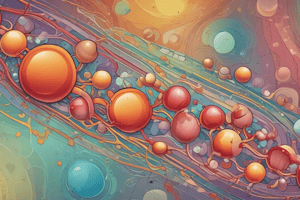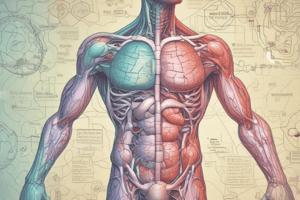Podcast
Questions and Answers
What is the main reason for the hydrophobicity of lipids?
What is the main reason for the hydrophobicity of lipids?
- The presence of triacylglycerol
- The short -hydrocarbon chains
- The long -hydrocarbon chains (correct)
- The presence of phospholipids
In infants, what catalyzes the digestion of dietary lipids in the stomach?
In infants, what catalyzes the digestion of dietary lipids in the stomach?
- Gastric lipase
- Pancreatic lipase
- Lingual lipase
- Both A and B (correct)
What is the main component of dietary lipids?
What is the main component of dietary lipids?
- Lecithin
- Cholesterol
- Triacylglycerol (correct)
- Phospholipids
What is the role of pancreatic lipase in the digestion of dietary lipids?
What is the role of pancreatic lipase in the digestion of dietary lipids?
Why is the rate of hydrolysis slow in the stomach?
Why is the rate of hydrolysis slow in the stomach?
What is the function of phospholipase A2 in the digestion of dietary lipids?
What is the function of phospholipase A2 in the digestion of dietary lipids?
How are lipids absorbed by intestinal mucosal cells?
How are lipids absorbed by intestinal mucosal cells?
In adults, where do dietary lipids progress to after passing through the stomach?
In adults, where do dietary lipids progress to after passing through the stomach?
What is the primary function of mixed micelles in the intestinal lumen?
What is the primary function of mixed micelles in the intestinal lumen?
What is the fate of free fatty acids in the body?
What is the fate of free fatty acids in the body?
What is the primary destination of glycerol in the body?
What is the primary destination of glycerol in the body?
Which of the following fatty acids does not require the assistance of a micelle for absorption?
Which of the following fatty acids does not require the assistance of a micelle for absorption?
What is the primary outcome of fatty acid oxidation in cells?
What is the primary outcome of fatty acid oxidation in cells?
Flashcards are hidden until you start studying
Study Notes
Lipids
- Lipids are a heterogeneous group of water-insoluble (hydrophobic) organic molecules due to their long hydrocarbon chains.
- Hydrophobicity causes lipids to be insoluble in aqueous solutions, leading to compartmentalization in membranes or as droplets of fat in adipose tissue, or transportation in plasma as lipoprotein particles.
Digestion of Dietary Lipids
- Dietary lipids consist of 90% triacylglycerol (TAG) and 10% cholesterol and phospholipids.
- In infants, digestion begins in the stomach with acid-stable lingual lipase and gastric lipase, targeting TAG molecules with short or medium chain fatty acids.
- In adults, dietary lipids are not digested in the mouth or stomach, but rather progress intact to the small intestine.
Pancreatic Enzymes
- Pancreatic lipase hydrolyzes triacylglycerols to 2-monoacyl glycerol and 2 free fatty acids.
- Phospholipase A2 removes a fatty acid at carbon 2 of a phospholipid, leaving a lysophospholipid.
- Cholesterol esterase converts cholesteryl-esters to cholesterol and a free fatty acid.
Absorption of Lipids
- Lipids are absorbed by intestinal mucosal cells through micelles formation, with bile salts, free fatty acids, free cholesterol, and 2-monoacylglycerol forming clusters of amphipathic lipids.
- Short and medium chain-length fatty acids do not require micelles for absorption.
Fate of Lipids
- Free-fatty acids can directly enter adjacent muscle cells or adipocytes, or be transported in blood with serum albumin.
- Most cells can oxidize fatty acids to obtain energy (ATP).
- Glycerol is used by the liver or kidney to produce glycerol-3-phosphate, which can enter glycolysis or gluconeogenesis by oxidation to dihydroxyacetone phosphate.
Studying That Suits You
Use AI to generate personalized quizzes and flashcards to suit your learning preferences.





